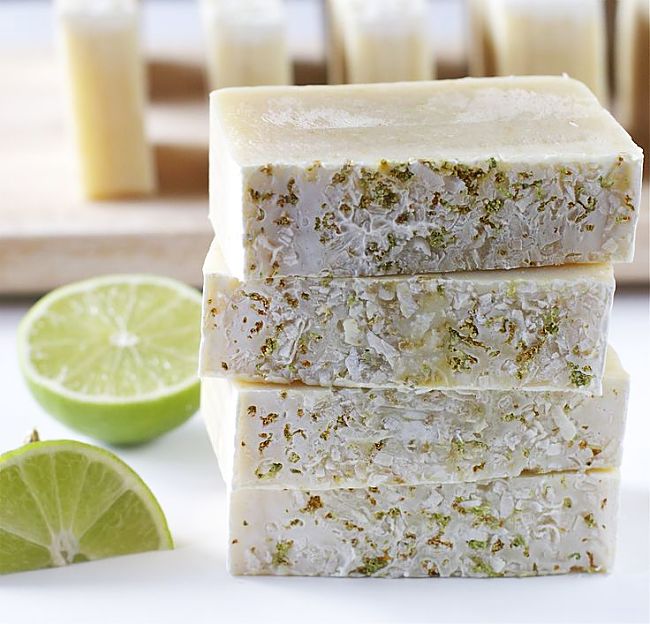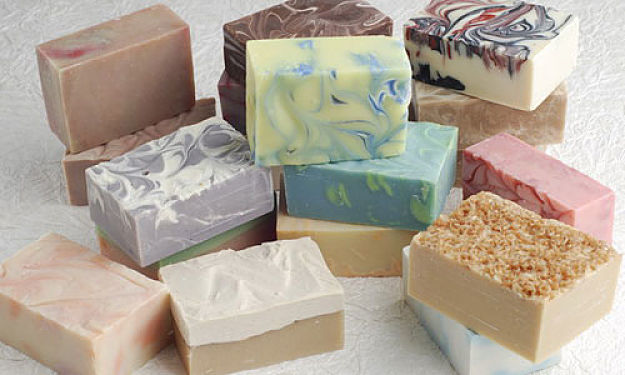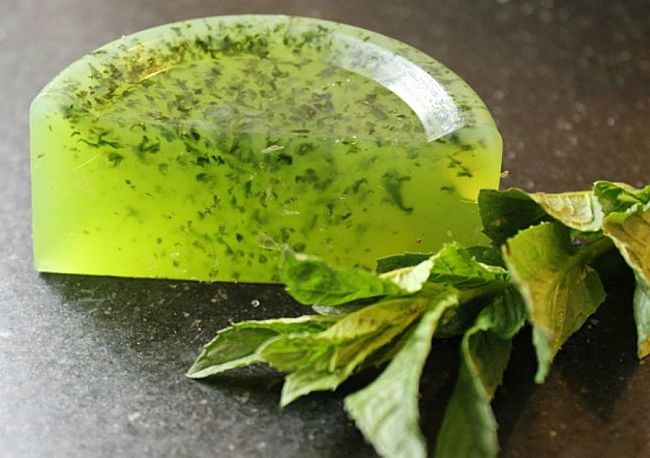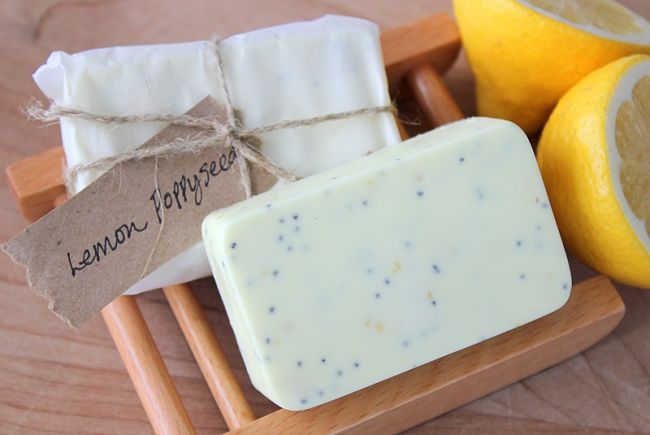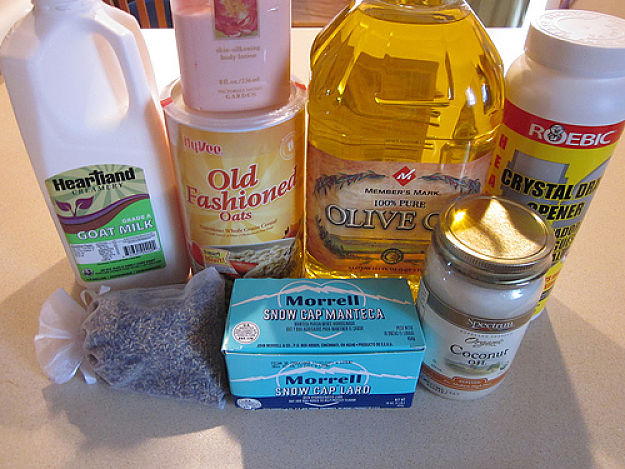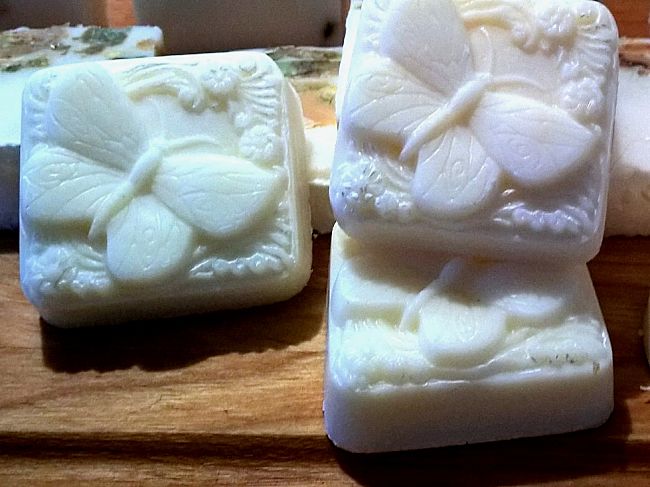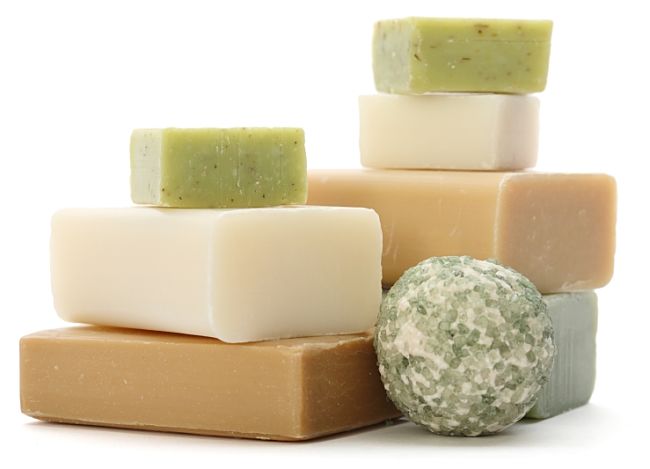Making Homemade Soap - Ingredients, Recipes, Cold, Hot, Melt and Pour, Liquid
The hard soap bars that you buy in shops are tough, lifeless and unappealing.
However, like homemade bread, homemade soap has life and character and showcases what you the soap-maker puts into it. Homemade soap feels good in the hand, it smells good, it feels alive and inviting. Again just like homemade bread - ignorance is bliss - you don't know what you are missing until you have tried real natural hand made soap.
You will be surprised that there are many ways of making your own soap, which are much easier than you think.
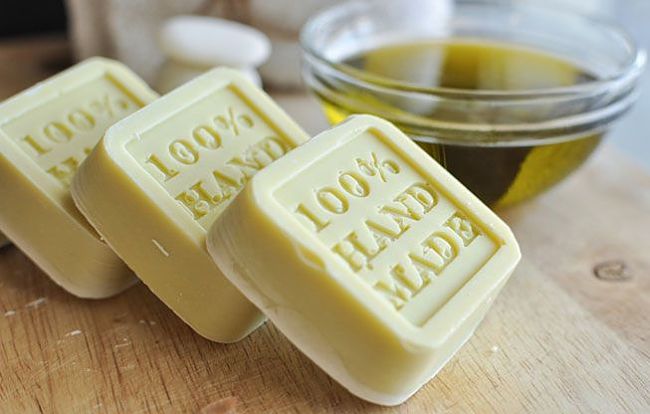
How to Make Soap at Home
Soap is make using a simple chemical reaction between oils and/or fats and lye, which are strong alkaline substances, ether sodium hydroxide (NaOH, known as 'caustic soda') or potassium hydroxide (KOH) - used for making liquid soaps.
While that is the chemistry the 'devil is in the details'. Just as you can make a rock hard primitive loaf of bread with the basic ingredients of flour and water - you can make lifeless rock hard soap. Or if you go to some trouble and get a good recipe you can include lots of other ingredients including your favorite whole-grain flour, a mixture of other flours, honey, herbs, eggs, sea salt, yeast that transform a simple bread into a remarkable home made delight.
Four Ways of Making Soap
There are four fundamental methods for making homemade soap each of which has its own pros, and cons:
- Melt and Pour Method - this is the simplest and all you do is to melt existing prepared blocks of plain soap, that you can buy and add your own fragrance and oils to make a personal soap
- Cold Process Method - the most common and traditional way of making soap from the raw ingredients with oils and lye
- Hot Process Method - similar to the cold process, but where the soap is heated and cooked
- Re-batching Method - this method involves grinding up existing bars of soap, adding water or milk and re-blending these ingredients with added fragrances and oils.
- Liquid soap - this is very hard to do at home and requires a lot of experience.
Melt and Pour Soap Making
This is a great way to start as no chemicals are involved.
- You start by buying pre-made blocks of plain soap from a health food shop or craft store.
- You melt the soap base in a double boiler ( most controlled method) or using a microwave.
- When the soap is liquid, you add your colors, fragrances and oils.
- Carefully pour the melted soap into a mold - you can buy these from craft shops or innovate using what you have.
- The soap is ready to go as soon as it cools and hardens.
Pros
- A simple, inexpensive and easy way to get started making soap
- No risks of dealing with dangerous lye chemicals
- Few ingredients required
- You know it will work
- Your soap is ready to use as soon as hardens
Cons
- No control over the basic soap ingredients
- Denies you the experience of real soap making
- The soap is not as 'natural' as other methods
- Your soap is only as good as the base soap you buy
Cold Process Soap - Starting with the basic ingredients
To make soap this way, you add the oils you want in your soap to a heavy pot and heat oils to a temperature of about 150 degrees F or 60 degrees Centigrade. Then you very carefully add the lye-water mixture to the oil (never the other way around) and stir the soap until it thickens to form a 'trace' - (thickens, so that a trace is left when you drag something across the surface). You then add your fragrance, scent, additives and colors and pour the hot liquid soap into molds (greased with vegetable oil). The raw soap in the molds will require about 24 hours to harden fully and an additional four weeks or so cure fully before it’ is ready to be used.
The basic ingredients and equipment required are:
- A jug of lye-water mixture
- Some animal fats or vegetable oils
- A soap pot
- Essential oils, scents, fragrances or other additives
- Natural or synthetic colors suitable for soaps
- molds for shaping raw blocks of soap
- Rubber / cooking gloves and protective glasses
Pros of Cold Process Soap Making
- Your soap is genuinely made from the basic ingredients
- You have control all the ingredients in the soap, including the fats and oils used
- You can put your personal touch into the recipe interns of the colors and fragrances
Cons of Cold Process Soap Making
- You need to work very carefully with lye which is a very dangerous substance
- You’ll need a lot more ingredients and tools to make the soap
- It takes much longer to make, more equipment, it required more cleanup, and several weeks for the soap to cure before it can be used
Simple Soap Recipes
Vegetable Oil Soap
- 24 oz (680 g) coconut oil
- 24 oz (680 g) olive oil
- 18-20 oz (550 g)soybean or canola oil (less will yield a slightly harder finish)
- 16 oz (500 g) palm oil
- 24-26 oz (200 ml) cold water
- 12 oz (340 g) lye crystals
- Temperatures 100-120 degrees F (40-50 degrees C) (varies according to what you use for fragrance - some fragrance oils work at higher temperatures).
Classic Soap Recipe
- 39 oz (1100 g) olive oil (For harder soap substitute a small amount of cocoa butter for 2 oz 55 g) the olive)
- 24 oz (680 g) coconut oil
- 18 oz (550 g) palm oil
- 26-30 oz (750 ml) cold water (lower for essential oils, higher for troublesome fragrance oils)
- 12 oz (340 g) lye crystals
- Fragrances and oils
- Temperatures around 100 to 110 degrees F (40-45 degrees C).
Good Oils and Fragrances for Adding to Soaps
* Apricot kernel oil
* Castor oil
* Macadamia oil
* Olive oil
* Rice bran oil
* Sweet almond oil
* Virgin coconut oil
Popular fragrances and scents include:
*cinnamon
*willow bark
*apple
*vanilla
*peach
*rose
*green tea
and many others
Other Natural Ingredients and Additives:
* Golden Jojoba
* Mango butter
* Shea nut butter
* Cocoa butter
Basic Method for Making Soap from Raw Ingredients
The Oil Phase
Gently heat oils in a stainless steel pot on the stove. Be careful not to burn oils.
Or use microwave-safe container for your oils. Heat for 1 minute on high, then use 20 second intervals thereafter, until the required temperature is reached. (100°F, 50°C check your recipe). Heat oil to 10°C past the required temperature per formula. This will allow time for the lye to cool to its correct temperature. Always heat oils before mixing lye and water.
The Lye/Water Phase
Pour room temperature distilled water (amount specified by formula) into a clean glass 2 cup size measuring cup. While stirring, slowly and carefully add the lye. This mixture will quickly become very hot. NEVER ADD WATER TO THE LYE as it may Spit or explode. Continue stirring until the water turns clear. Wear Gloves and do not inhale the fumes. Let this mixture cool to the required temperature (100°F, 50°C check your recipe).
The Trace Phase
Pour the hot oil into a large mixing bowl and slowly pour the lye/water mixture (at the same temperature) into the oil mixture while stirring in rapid, small circles. [Note: Always add lye/water to oil, not the other way around]. Continue to stir this mixture using a rapid, figure 8 pattern until it "traces". Tracing is easily recognized. Using a plastic spatula, drizzle a small amount across the top of the soap mixture. If a mark or trail remains for a few seconds before disappearing again, your soap has traced. The mixture should be the consistency of liquid honey or pudding before it is poured.
Adding Fragrances and Extracts
After the soap traces, you can add your own fragrances and colors. Note: Do not use perfume, synthetic fragrances, or extracts of any kind as the alcohol content may interfere with the soap making process.
Pouring into Molds
After adding any additional ingredients, pour your soap mixture into the mould. Place a piece of clear plastic wrap on top to create an air barrier. Cover your mould with a blanket or towel and place in a warm location away from drafts and childreni.a reach. Let set undisturbed for the specified moulding time as stated in the formula for your oil blend.
Tip for Moulding
Grease your mould with vegetable shortening for ease of release later. Wear gloves during clean up and use hot water and dish soap to remove all residue from equipment.
